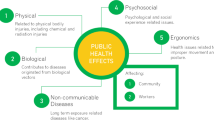Abstract
Lack of adequate sanitation, hygiene and safe portable water are serious global health problems that contribute to deaths of many children under the age of 5 years annually, mainly due to diarrhoeal diseases. This study was set out to determine the extent to which sanitation and hygiene promotion influenced mothers’ and children’s health in Turkana District; one of the arid Northern frontier Districts of Kenya. A repeat cross-sectional study design with multi-stage sampling method was used. A total of 300 mothers were randomly sampled for interviews in a baseline survey carried out in 2007 and in a post-intervention survey carried out in 2008. Data were collected using questionnaires and analyzed using SPSS for frequencies, cross tabulations and regression amongst other tests. Significant improvements were observed in hand washing practice, presence of hand washing soap at household and refuse pit ownership. In Kakuma Division the proportion of those who washed hands regularly increased from 48.8 to 91.3 % (χ2 = 7.28, P = 0.122), in Lodwar Central, those who wash hands regularly increased from 85.5 to 89.9 % (χ² = 10.85, P = 0.028) while in Lokichogio, the proportions increased from 77.5 to 93.8 % (χ² = 15.56, P = 0.004). For hand washing soap at household, there was an increase in proportion of those who wash hands with soap from 65 to 78 % (χ² = 3.87, P = 0.049) within the group with no formal education. There was significant reduction of diarrhoea prevalence in children aged less than 5 years. Sanitation and hygiene promotion based on community participatory approaches can lead to significant reduction of diarrhoea in children.




Similar content being viewed by others
References
Pruss, A., Kay, D., Fewtrell, L., & Bartram, J. (2002). Estimating the burden of disease from water, sanitation and hygiene. Journal of Environmental health perspectives, 110, 537–542.
International Water and Research Centre (IRC) and Water Engineering Development Centre (WEDC). (2002). Sanitation connection theme, health and social. Available online at http://www/helpdesk@sanicon.net/ud.html. Accessed 12 February 2012.
Black, M., & Fawcett, B. (2008). The last taboo: Opening the door on the global sanitation crisis (1st ed.). Trowbridge, UK: Earthscan, Cromwell Press.
WHO/UNICEF. (2010). Progress on sanitation and drinking water. (2010). update Geneva. Available online at WHO http://www.who.int/water_sanitation_health/publications/9789241563956/en/index.html. Accessed 12 February 2012.
Cumming, O. (2008). Tackling the silent killer: The case for sanitation. WaterAid, London, UK. Available online at http://www.wateraid.org/documents/tacking_the_silent_killer_the_case_for_sanitation.pdf. Accessed 12 March 2012.
Bajracharya, D. (2003). Myanmar experiences in sanitation and hygiene promotion: Lessons learned and future directions. International Journal of Environmental Health Research, 13, 141–152.
Narathius, A. (1994). Health related behaviours in Bukalimo village and in Mpande/Nakazinga village; RUWASA project. Available online at http://www.watsanuganda.watsan.net/page/420. Accessed 12 February 2012.
Gilman, R. H., Marquis, G. S., Ventura, G., & Campos, M. (1993). Water cost and availability, key determinants of family hygiene in a Perufian Shanty Town. American Journal of Public Health, 83, 1554–1558.
Central Bureau of Statistics, Ministry of Finance and Planning in Nairobi, Kenya. (2002). Kenya 1999 population and housing census, the popular report.
Lemeshow, S., et al. (1990). Sample size determination in health studies: A practical manual (1st ed.). Geneva, Switzerland: WHO.
Van Wijk-Sijbesma, C. (1998). Gender in water resources management, water supply and sanitation—roles and realities revisited, International Water and Sanitation Centre, The Hague, Netherlands. Available online at http://www.irc.nl/page/1893. Accessed 12 February 2012.
McLennan, A. (2000). Urban development debates in the new millennium: Studies in revisited theories and redifined praxs (Vol. 3). India: Atlantic publishers.
Curtis, V., & Cairncross, S. (2003). Effect of washing hands with soap on diarrhoea risk in the community: A systematic review. Lancet Infectious Disease, 3, 275–281.
Kar, K. (2005). Practical guide to triggering community-led total sanitation. Available online athttp://www.communityledtotalsanitation.org/sites/communityledtotalsanitation.org/files/Guidelines_for_triggering_CLTS_0.pdf.
Sidibe, M., & Curtis, V. (2002). Water and sanitation programme, hygiene promotion in Burkina Faso and Zimbabwe: New approaches to behaviour change, WSP Field Note 7, August 2002.
Acknowledgments
We thank Unicef, Kenya Country Office who accepted this nested repeat cross-sectional study to be undertaken in their project.
Conflict of interest
None.
Author information
Authors and Affiliations
Corresponding author
Rights and permissions
About this article
Cite this article
Kariuki, J.G., Magambo, K.J., Njeruh, M.F. et al. Changing Mother’s Hygiene and Sanitation Practices in Resource Constrained Communities: Case Study of Turkana District, Kenya. J Community Health 37, 1185–1191 (2012). https://doi.org/10.1007/s10900-012-9561-0
Published:
Issue Date:
DOI: https://doi.org/10.1007/s10900-012-9561-0




